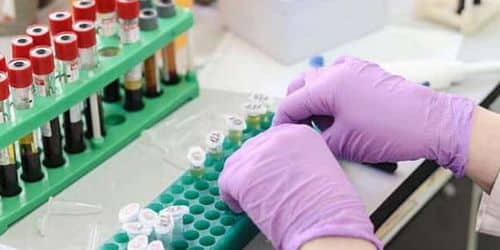Employers carry out drug screening to find out if you have abused one or more drugs. It cannot, however, detect a drug use disorder (addiction). There is a significant difference between a drug screen and a drug test. But, drug screening and testing use similar methods.
What Is Drug Screening
A drug screen involves the scientific analysis of a biological specimen, such as urine, hair, blood, breath, sweat, or oral fluid/saliva, to determine the presence or absence of a particular parent drug or its metabolites. The detection windows are influenced by a variety of factors, including drug class, dosage, frequency of use, metabolic rate, body mass, age, general health, and urine pH.
A biological sample (such as blood or urine) is used in a drug screen to determine whether a substance is legal or illegal. The settings and procedures used to order and conduct drug screening vary greatly. Drugs include legal substances like alcohol and tobacco as well as over-the-counter, prescription, and illegal narcotics. A single drug test is unable to determine the frequency and intensity of substance use and cannot differentiate between normal substance use and substance use disorders.
Because different drugs are metabolized (broken down) by your body at varying rates, it can be difficult to predict when you will be able to test positive for a particular drug. The most widely used method of detecting drugs is urine drug testing (UDT).
The most basic (and frequent) drug tests look for amphetamines, heroin, morphine, cocaine, PCP, and the basic opiates (heroin, morphine, and codeine). The length of time it takes to receive the results of a drug test depends on the type of test, the purpose of the test (such as an emergency or employment screening), and the reason for the test.
Results from urine and blood drug tests are typically available more quickly than those from hair drug tests.
The results of drug tests are either positive or negative. A positive test result means there is the presence of a drug at or above the reference range for that particular test. A negative test result means the drug wasn’t found or the amount detected wasn’t enough to produce a positive test result.
Interpreting The Drug Screening Results
A positive drug test result simply indicates that the subject had a substance in their system for a specific amount of time. A positive test result doesn’t necessarily mean the subject is high or under the influence of the substance. Additionally, a positive outcome does not always indicate that the subject suffers from a substance use disorder. In most cases, they will carry out additional testing to confirm positive results from an initial drug test. Some drugs and foods can lead to erroneous positive results.
A negative result on a drug test simply indicates that they could not detect a specific substance; it does not, however, exclude recent substance use or a substance use disorder. False-negative results, which occur when a person tests negative for drugs despite using or abusing drugs, can occur for several reasons, such as:
- Incorrect sample collection or analysis.
- The person made an attempt to rig a drug test, perhaps by using someone else’s urine sample.
- A substance isn’t assessed in a particular test (for instance, not all amphetamines are tested in amphetamine testing).
What Is Drug Screening for Employment
Employers may decide to conduct drug tests on employees to maintain a secure and effective workplace. For many job applications, a drug test is a prerequisite. As part of the company’s drug-free workplace program, existing employees may be subject to sporadic or random testing. After work-related accidents, after drug treatment, or if there is a solid suspicion that a worker is abusing substances that could be dangerous at work, the employer may request screening services. Drug tests are typically used in the workplace. Employers may demand a drug test for several reasons, such as:
- Before hiring a candidate.
- An employer may request drug testing of a worker at any time during their employment, whether at random or regularly.
- when there are signs and symptoms at work that lead one to believe someone is using drugs.
- following an employee’s accident or incident at work.
A drug test can examine your body for a specific drug or a collection of drugs. Drug tests frequently look for:
- Alcohol
- Amphetamines
- Barbiturates
- Benzodiazepines
- Cocaine
- Marijuana
- Opioids and opiates
- Phencyclidine (PCP)
- Steroids
Drug Screening Methods
Depending on the biological sample they use and the substances they look for, there are different kinds of drug tests. Depending on the sample, there are various kinds of drug tests, including:
#1.Urine Drug Testing (UDT):
The majority of drug tests use this method. A sample of your urine (pee) is necessary. You can use urine drug tests to find alcohol, amphetamines, benzodiazepines, opiates/opioids, cocaine, and marijuana (THC). The main reason urine analysis is used is that it is inexpensive. One of the most popular methods for drug screening is Urine analysis
#2. Blood Drug Testing
These tests are typically only used in emergencies by healthcare professionals. Because it can give a precise level, healthcare professionals also use it to measure alcohol (ethanol) levels. One of the drug screening methods is the use of blood.
#3. Hair Follicle Drug Testing
An analysis of a hair sample can reveal patterns of substance use. The detection window for scalp hair is three months, whereas the detection window for slower-growing body hair is up to twelve months. Depending on the individual’s hair characteristics, the outcomes may differ. Hair samples can be used to test for cocaine, PCP, amphetamines, opioids, and 3,4-Methylenedioxymethamphetamine (MDMA) use. The use of hair follicles is also one of the methods for screening a drug.
#4. Breath Drug Testing
This is also one of the methods for drug screening. The main purpose of this is to identify recent alcohol consumption. A breath alcohol concentration (BrAC) is the outcome. Officials often use it to estimate a person’s blood alcohol content (BAC). The BrAC, though, occasionally overestimates or underestimates the BAC.
Recent studies have centered on the potential use of breath testing to find drugs like methadone, buprenorphine, cocaine, marijuana, benzodiazepines, amphetamines, and opioids. By taking a deep breath, a breath test calculates the body’s alcohol content. The Breathalyzer, a device invented in 1954 that set itself apart from other breathalyzers by containing chemicals, is a well-known example.
#5. Sweat Drug Testing
Sweat tests involve applying an absorbent pad to your skin, which is then removed after a predetermined amount of time and tested. The results show how much of a substance was consumed by the subject throughout the entire time they wore the pad. Sweat tests provide a detection window that ranges from hours to weeks. Sweat testing is also one of the methods of drug screening.
Drug Screening vs Drug Test
You can use a drug test to detect the presence of drugs in someone’s system, whereas identifying specific drugs is done through a drug screen. In contrast to a drug test, which can identify any drug, a drug screen can only detect a small number of drugs. Contrary to drug tests, which may be administered at any time, including years after a person has stopped using drugs, drug screens are typically conducted as soon as a person is suspected of using drugs.
Drug tests can identify drugs that have been used in the past, whereas drug screens can only identify drugs that have been recently used. Also, drug screens typically cost less than drug tests. Drug screens are not as accurate as drug tests and sometimes produce false positives. Drug screens are less accurate than drug tests and occasionally fail to detect drugs in a person’s system. In contrast to drug tests, which can also use other specimens such as blood, hair, and nails, drug screens typically only use urine or saliva as the source of the material.
Drug screens don’t always need confirmation, while drug tests always need confirmation via a different test before you can take them into consideration as valid. Contrary to popular belief, a drug test itself is typically more difficult than a drug screen.
Drug test results can take several hours to several days to be available, while drug screen test results are typically available in a matter of minutes. If you’re not sure whether you need a drug test or drug screen, it’s important to consult a medical expert to determine the best course of action.
What Happens During a Drug Screening?
Numerous places, including laboratories, hospitals, drug treatment facilities, and workplaces, may conduct drug tests. You must provide a urine sample for the majority of drug tests. You’ll receive instructions on how to collect your sample.
In some circumstances, you might need to give your sample in front of a medical professional or another person. This is to ensure that the urine is yours and confirm that you did not taint it with anything that could skew the test results.
A medical professional will use a small needle to draw blood from a vein in your arm to be tested for drugs. They will draw out a little blood sample and put it into a test tube or vial after withdrawing the needle. The needle may sting slightly as it enters or exits your body. Normally, this takes under five minutes.
What Is The Difference Between a Drug Test and a Drug Screen?
Although the terms “drug test” and “drug screening” are frequently used interchangeably, they have some significant distinctions. A drug test is typically more thorough and accurate than a drug screening, but a drug screening offers quicker results and is a more economical method.
What Is a Standard Drug Screening?
A typical drug test finds specific, everyday substances. Urine drug tests check to see if a parent drug or one of its metabolites is present. The most popular method of testing for drugs and alcohol is the urine test. Employers may conduct it as part of a pre-employment screening, at random, or after an accident, especially for workers in specific occupations.
The only testing technique currently authorized for use in federally required testing is urinalysis. Although saliva and hair tests are also available, urine testing has long been the gold standard. It is both affordable and efficient. Urine tests can detect a wide range of drugs.
What Makes You Fail a Drug Screen?
A drug test can find the presence of specific drugs and substances. Urine testing is the most popular type of drug test. Unfortunately, there can be inaccurate results on drug tests.
An example of a “false positive” is when a drug test detects a substance or medication that you aren’t using. But how does this happen?
An error in the lab can occasionally lead to a false positive. But more often than not, a particular medication is to blame for a false-positive result.
A urine drug test may yield “false positive” results due to certain medications. This means that they can detect certain substances or medications that you haven’t taken during the test.
Medications that can produce false positive results include antidepressants, decongestants, and dextromethorphan (a component of Robitussin and Delsym).
Can You Fail a Drug Screen?
A drug test can find out if a person is using specific drugs and medications. The most typical kind of drug test is a urine test. Unfortunately, drug tests occasionally produce false positives. A “false positive” occurs, for instance, when a drug test detects a substance or medication that you aren’t using.
What Happens if You Don’t Pass a Drug Screening?
Many job applications come with a standard requirement: a drug test. What happens then if you don’t pass the drug test for the job? You will probably lose your job if the validity of the test result is established (especially after several retests). If a drug test was necessary as part of the hiring process, the company will probably revoke its job offer.
How Long Do Drugs Stay in Your System Chart?
Drugs can be either prescription or illicit. The range in how long these drugs remain active in the body is as wide as the variety of drugs. After ingestion, the duration of each drug’s effects on the body varies. However, the variation doesn’t end there. In addition to the particular drug type, numerous other factors affect how long it takes the body to eliminate a drug from the system.
- the dosage
- existence of additional drugs in the body.
- Age.
- Ethnicity
- Sex.
- Weight.
- prevalence of diseases like kidney issues that have an impact on drug elimination.
A drug like Xanax, for instance, is affected by a person’s age, level of health, and ethnicity. People who are obese, older than 64, have liver issues, or who are Asian or white will experience the effects of the drug for a longer period. Although there are some general guidelines, it can be challenging to precisely predict how long a drug will remain in the body or be detectable in a test.
Conclusion
There are numerous uses for drug testing. Although taking a drug test can be anxiety-provoking, you should know that medical professionals and authorities carefully review and interpret the results. The majority of the time, a confirmatory test is necessary after a positive drug test result to rule out any potential false-positive results. Speak with the person in charge of ordering the test if you have any inquiries regarding the procedure for a drug test or when to anticipate the results.
What is Drug Screening FAQ
What is Drug Screening?
A drug screen involves the scientific analysis of a biological specimen, such as urine, hair, blood, breath, sweat, or oral fluid/saliva, to determine the presence or absence of a particular parent drug or its metabolites
What Are The Methods Used In Drug Screening?
- Urine Analysis
- Blood Testing
- Sweat TestungTesting
What Is The Difference Between a Drug Test and a Drug Screen?
Drug tests can identify drugs that have been used in the past, whereas drug screens can only identify drugs that have been recently used.





